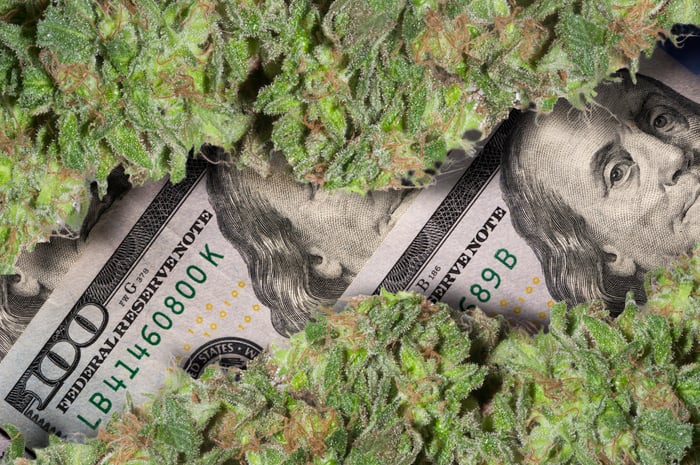Marijuana stocks may not have had a banner year in 2018, but the cannabis industry made waves like never before. When the curtain closed, Canada had become the first industrialized country in the world to give the green light to recreational weed, paving the way for billions of dollars in legitimate annual sales, and pulling cannabis out of the shadows and into the spotlight as a valid business model.
We also witnessed plenty of history made in the U.S., too. In December, President Trump signed the farm bill into law, legalizing hemp and hemp-based cannabidiol products throughout the country. Additionally, the U.S. Food and Drug Administration approved its very first cannabis-derived drug, and a handful of states legalized pot in some capacity. Roughly two-thirds of all states have now legalized medical cannabis, with 10 of those states also allowing adult consumption.
In other words, this is a fast-growing industry -- and business is about to pick up.

Image source: Getty Images.
Global marijuana sales could approach $17 billion in 2019
According to a report ("2019 Update to The State of Legal Marijuana Markets") released on Monday, Jan. 15, by Arcview Market Research and BDS Analytics, global consumer cannabis spending is expected to skyrocket by 38% in 2019 to $16.9 billion, up from an estimated $12.2 billion in 2018, $9.5 billion in 2017, and $6.9 billion in 2016. Furthermore, compound annual sales growth between 2017 and 2022 is expected to clock in at 26.7%, with the report calling for $31.3 billion in global marijuana sales in 2022.
Interestingly enough, Arcview's & BDS Analytics' global sales estimate for 2018 came in a bit below previous forecasts that were issued at this time last year. Originally, Canadian Prime Minister Justin Trudeau had been aiming for a July 1, 2018, launch for recreational weed, but the passage of the Cannabis Act didn't occur until mid-June. The three-and-a-half-month delay of the launch of adult-use marijuana in Canada, compounded with initial supply shortages caused by regulatory red tape (e.g., cultivation license and sales permit approvals), is one reason their global sales forecast wasn't met.
The other factor adversely affecting global sales in 2018 were supply issues in California. A number of growers overproduced cannabis, driving the per-gram price lower, while regulatory red tape in the dispensary approval process slowed the opening of new retail outlets.
However, 2019 is expected to be a different story.

Image source: Getty Images.
These will be 2019's major cannabis growth drivers
As you might expect, the legalization of cannabis in various U.S. states and in other countries around the world is likely to be one of the biggest sales catalysts. Within the U.S., both the states of New Jersey and New York appear to be on the verge of legalization within their respective state legislatures. This comes after Michigan voters chose to approve Proposal 1 in the November midterm elections, legalizing recreational marijuana.
Looking abroad, there's plenty of opportunity for Mexico to possibly move forward with legalized adult-use marijuana, as well as for a number of Asian countries to pass medical cannabis laws. Legalizations will drive future growth, which is why Arcview and BDS Analytics are now calling for $31.3 billion in global sales by 2022.
Don't overlook the expansion of legalized consumption options in Canada, either. When the Cannabis Act was passed, just dried flower, sublingual sprays, and cannabis oils were legalized. Other forms of consumption, such as edibles, topicals, extracts, and cannabis-infused beverages weren't given the green light. But according to a draft released by Health Canada in December, these new options will be legalized for sale in the coming fall, and by no later than the one-year anniversary of recreational legalization in Canada, Oct. 17. These new consumption options tend to be high margin, and are therefore expected to be pushed by cannabis growers.
Another reason weed sales could soar in 2019 is the expectation that some supply kinks will work themselves out. As an example, California is likely to see its pot oversupply lessen as new legal dispensaries open for business. Meanwhile, Health Canada's ability to power through a backlog of cultivation licenses and sales permits should allow more product to hit dispensary store shelves.
Lastly, don't discount dealmaking activity between brand-name beverage, tobacco, and pharmaceutical companies and cannabis businesses. Larger beverage, tobacco, and pharma businesses have been looking for a way to diversify their product portfolios and reignite growth. Partnering with or investing in pot stocks could be that answer and lead to a surge in revenue.

Image source: Getty Images.
Looking for a big piece of the cannabis pie
In terms of aggregate sales, there's a very good chance that Canopy Growth (CGC -6.15%) and Aurora Cannabis (ACB 1.42%) will find themselves at the top of the pack, albeit for different reasons.
Aurora Cannabis is expected to be a dominant player as a result of its peak production potential. Although Aurora's press releases will downplay this peak annual output at "over 500,000 kilograms," the company is more than capable of 700,000 kilograms per year, when at full capacity, following its acquisition of ICC Labs in South America for about $221 million. Should Aurora Cannabis choose to fully develop leased and owned land adjacent to existing grow facilities, it could possibly boost its annual yield to north of 1 million kilograms.
While it's unclear what the peak production potential is in Canada, Aurora Cannabis could ultimately be responsible for in the neighborhood of 15% to 20% of the country's aggregate production. Mind you, not all of this weed will be consumed by Canadians. Rather, quite a bit will be exported to countries where medical marijuana is legal.
In the meantime, Canopy Growth, which is likely to slot in as the second-largest producer with more than 500,000 kilograms of annual peak output, is expected to lean on its superior sales channels, branding, and partnerships to drive sales growth.

Image source: Getty Images.
In November, Modelo and Corona beer maker Constellation Brands closed on a $4 billion equity investment in Canopy, giving it a 37% equity stake in the world's largest pot stock. This cash infusion should prove important in allowing Canopy Growth to execute on its business strategy, which includes moving into new international markets, developing additional alternative cannabis products, and making complementary acquisitions. Just this past week, Canopy Growth announced that it will be investing $100 million to $150 million in a hemp processing facility in southern New York state after being awarded a license to do so by the state.
Canopy Growth also has what's arguably the most recognized cannabis brand throughout Canada (Tweed) and the most developed sales channels (physical and online) to move that product from field to consumer.
Even though the cannabis industry is built on the hope of small businesses thriving, it wouldn't be in any way surprising to see this duo leading the growth charge in 2019 and gobbling up market share.
Check out all our earnings call transcripts.





